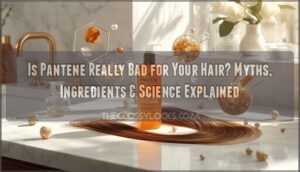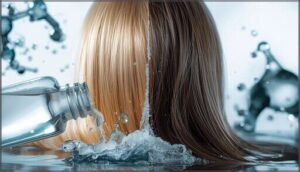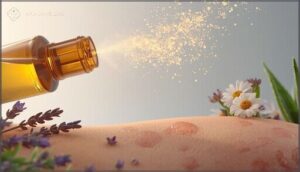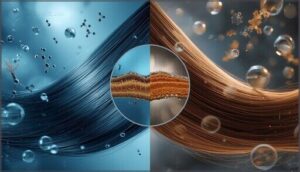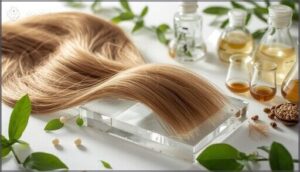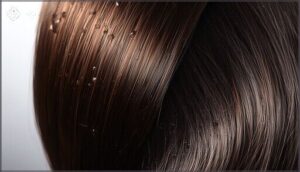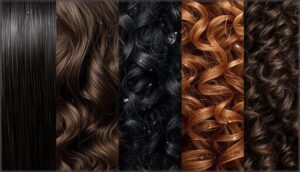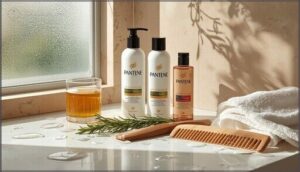This site is supported by our readers. We may earn a commission, at no cost to you, if you purchase through links.
For decades, Pantene has sat on bathroom shelves worldwide, yet rumors about its supposed hair-damaging effects persist in online forums and beauty circles. Some claim it causes breakage, buildup, or even hair loss—but these assertions rarely cite scientific evidence.
The truth is more nuanced than viral warnings suggest. Pantene’s formulas contain ingredients common to most mass-market shampoos, including sulfates, silicones, and preservatives that serve specific functions in hair care. While these components can cause issues for certain individuals, particularly those with sensitivities or specific hair types, clinical studies don’t support blanket claims that Pantene inherently ruins your hair.
Understanding what’s actually in the bottle—and how those ingredients interact with your unique hair chemistry—lets you make an informed choice rather than relying on myths.
Table Of Contents
- Key Takeaways
- Is Pantene Really Bad for Your Hair?
- What Ingredients Are in Pantene Products?
- Do Pantene Products Cause Hair Damage?
- Can Pantene Cause Hair Loss or Thinning?
- Does Pantene Lead to Product Buildup?
- Are Pantene’s Ingredients Worse Than Others?
- Is Pantene Safe for All Hair Types?
- How to Minimize Damage When Using Pantene
- What Does Science Say About Pantene Safety?
- Should You Switch From Pantene?
- Frequently Asked Questions (FAQs)
- Is Pantene a bad shampoo or conditioner?
- Does Pantene damage hair follicles?
- Is Pantene good for your hair?
- Does Pantene shampoo cause hair loss?
- Does Pantene make different types of hair products?
- Are Pantene products dangerous?
- Does Pantene work better than salon brands?
- Can Pantene repair already damaged hair?
- How long does Pantene buildup take?
- Is Pantene safe during pregnancy or breastfeeding?
- Conclusion
Key Takeaways
- Pantene’s formulas contain sulfates, silicones, and preservatives common to most drugstore shampoos, and clinical studies don’t support claims that these ingredients inherently damage hair or cause hair loss in healthy users.
- Product buildup from silicones becomes noticeable within three to six weeks of regular use, but you can manage this with clarifying shampoos used weekly for active lifestyles or monthly for color-treated hair.
- Your hair type and scalp sensitivity determine whether Pantene works for you—signs like persistent irritation, excessive dryness, or texture changes within two weeks indicate the formula doesn’t suit your needs.
- Pantene’s ingredient profile isn’t riskier than competing drugstore brands since all major companies follow identical FDA, Health Canada, and EU safety standards for cosmetic ingredients at regulated concentrations.
Is Pantene Really Bad for Your Hair?
How often have you heard warnings about Pantene’s reputation for hair damage or seen alarming claims shared online? Ingredient concerns swirl—think sulfates or silicones—but the science tells a more nuanced story.
Product buildup is real if you use Pantene too often, yet safety comparisons show its formulas aren’t outliers among drugstore staples. A class action lawsuit was even settled due to misleading customer claims.
If you’re worried about hair loss, know that current evidence doesn’t link Pantene to thinning or shedding. In short, most worries about Pantene require meaningful context to judge.
What Ingredients Are in Pantene Products?
It’s easy to ignore what actually goes into your shampoo and conditioner. The ingredients in Pantene play a bigger role in your hair’s health than you might think.
Here’s what you’ll find inside these bottles.
Sulfates and Their Effects
When you scan Pantene’s shampoo ingredients, sulfates like Sodium Laureth Sulfate often top the list. These surfactants create foam but can strip away natural oils, leaving hair dryness, scalp irritation, and long-term hair damage. For sensitive types, high sulfate concentration matters. If you’re concerned about environmental impact or irritation, sulfate alternatives offer a gentler path. Pantene utilizes Pro-Vitamin B5 in their unique formulas.
- Increased scalp sensitivity
- Faded hair color
- Weaker strands over time
- Amplified frizz
- Stinging during washing
Parabens and Preservatives
Next up are parabens and preservatives—common beauty product ingredients in Pantene’s shampoo lineup. While parabens prevent bacteria, they sometimes trigger scalp irritation or raise questions about endocrine disruption.
Preservative safety matters, especially since some preservatives, like formaldehyde releasers, are flagged in cosmetic ingredients. If you’re exploring paraben alternatives, check shampoo ingredients closely to reduce exposure to potentially toxic ingredients in your routine.
Silicones and Product Buildup
Silicones give Pantene hair products that smooth, glossy finish many crave. However, repeated use can lead to product buildup on the scalp, especially with heavy formulas or when layering hair care products.
The type of silicone matters—dimethicone is persistent, making clarifying shampoo frequency important. If hair feels weighed down or dull, consider how silicone buildup effects could be impacting your results.
Fragrances and Allergens
Regarding Pantene, fragrance is more than just a pleasant scent—it’s a complex mix of cosmetic ingredients that can trigger allergic reactions or scalp irritation, especially for those with fragrance sensitivity.
If you notice irritation symptoms—like redness or itching—check for allergen identification on the label and consider fragrance alternatives to minimize the risk of skin irritation and discomfort.
Do Pantene Products Cause Hair Damage?
Wondering if Pantene actually damages your hair is a common concern, and the answer isn’t always straightforward. Different ingredients interact with your hair and scalp in their own ways.
Let’s take a closer look at the main ways Pantene might affect your hair health.
Dryness and Brittleness
Ever noticed your hair feeling rough after washing? Sulfate stripping in Pantene can sap essential moisture, leaving hair brittle. Still, Panthenol benefits—like improved hydration—step in to help. To support hair health and reduce breakage:
- Limit overuse to avoid dryness
- Pair with a moisturizing conditioner
- Consider a clarifying shampoo to minimize buildup
It’s all about balanced hair care.
Protein Loss and Hair Texture Changes
While some shampoo ingredients can strip protein from hair, Pantene leverages protein rebuilding and bond-building antioxidants to help offset hair breakage. You’ll often notice manageability improvement and split-end reduction, especially when formulas contain panthenol. Clinical studies even show a boost in hair count with ongoing use.
Here’s a snapshot comparing Pantene’s effects on hair texture:
| Benefit | Pantene with Antioxidants | Regular Shampoo |
|---|---|---|
| Protein rebuilding | Yes | Variable |
| Manageability improvement | Noticeable | Modest |
| Split-end reduction | ≥85% in studies | Lower |
| Hair count | Higher retention | Fluctuates |
| Bond-building antioxidants | Present | Rare |
Impact on Sensitive Scalps
If your scalp seems fussy or quick to itch, you’re not alone—Pantene’s shampoo ingredients like sulfates or parabens can be scalp irritation causes, especially for those with product sensitivity. Allergic reactions aren’t uncommon, but dermatologists often recommend buildup reduction—think clarifying shampoos—to help maintain scalp health and comfort while using Pantene or similar hair care formulas in your routine.
Can Pantene Cause Hair Loss or Thinning?
It’s easy to feel concerned when you hear stories about shampoo and hair loss. Before drawing any conclusions about Pantene, let’s look closely at what’s really known.
Here are the facts you should consider.
Scientific Evidence on Hair Loss
Worried that Pantene could be behind your hair loss? Let’s dissect the science. Clinical study results consistently show Pantene’s formulas don’t trigger alopecia or follicle damage.
Clinical studies consistently show Pantene’s formulas don’t trigger hair loss or follicle damage
Ingredient safety data—including panthenol, niacinamide, and piroctone olamine—reflects broad regulatory compliance in the U.S. and Europe, with no evidence linking them to hair loss causes.
In brand comparisons, Pantene’s antioxidant blends actually support better hair retention rates than many mass-market competitors, especially in controlled studies on scalp health and hair damage from daily washing routines.
Myths Vs. Facts About Thinning
How often have you seen hair left in your brush and wondered if it’s thinning, not just regular shedding? It’s a common mix-up—shedding vs. thinning. Expert consensus is clear: Pantene isn’t on the shortlist for hair loss causes, despite the persistent conditioner fallacy.
Most visible “loss” during conditioning is simply normal turnover. Pantene studies show no link to increased hair thinning, and clinical trials demonstrate improved retention, especially where oxidative stress is managed.
So, real hair damage from Pantene? The science doesn’t support that worry.
Does Pantene Lead to Product Buildup?
Product buildup is more common than you might think, especially with daily use of certain ingredients. It can change how your hair looks and feels over time.
Here’s what to watch for and how you can manage it.
How Buildup Affects Hair Health
Even when you’re diligent with hair care, product residue can quietly chip away at hair health. Here’s how buildup from ingredients like silicones disrupts your scalp’s natural balance:
- Follicle Blockage prevents best hair growth and can spark inflammation.
- Microbiome Disruption encourages yeast overgrowth, increasing flaking and discomfort.
- Moisture Deprivation reduces the absorption of hydrating treatments, making hair dry and brittle.
- Scalp Irritation and Hair Fragility rise as residue accumulates, leading to itch, breakage, and even dullness.
Your scalp and strands deserve a clean slate.
Signs of Buildup and Solutions
When hair feels dry, crunchy, or its natural wave seems faint, that’s your sign: Buildup Identification is overdue. Uniform white flakes—distinct from dandruff—signal Scalp Flaking caused by silicones lingering after your regular shampoo. Styling suddenly feels harder? That’s likely residue blocking your best results. For a practical path forward, keep this at your fingertips:
| Symptom | Solution |
|---|---|
| Dry, frizzy strands | Clarifying Shampoos |
| Flat roots, no volume | Vinegar Rinses |
| Excess flakes | Residue Removal |
| Styling resistance | Adjust Hair Care Routine |
| Dull, itchy scalp | Prioritize Scalp Health |
Stay proactive—your hair will thank you.
Are Pantene’s Ingredients Worse Than Others?
It helps to know how Pantene really stacks up against the rest. Plenty of drugstore shampoos share similar ingredients, but the effect on your hair can vary.
Let’s break down how Pantene’s formulas compare side by side.
Comparison to Other Drugstore Brands
When you line up Pantene against other drugstore Hair Care Products, ingredient overlap stands out immediately. Like most Beauty Products at this price point, Pantene shampoo and conditioner lean on sulfates and silicones—the same building blocks found in Garnier and L’Oréal.
Buildup comparison studies show similar long-term results, so the “residue” problem isn’t unique to Pantene. Performance testing highlights that Pantene often ranks just as high for softness and manageability.
With nearly identical price points and wide market share, Pantene isn’t an outlier—it’s right in step with its peers.
Ingredient Safety in Context
Regulatory compliance keeps Pantene and its drugstore competitors in check. The US FDA, Health Canada, and the EU all approve the same roster of cosmetic ingredients at safe concentrations.
Risk assessments from peer-reviewed studies show sulfates, parabens, and silicones rarely trigger systemic harm at the levels you’re washing out of your hair. Consumer perception often lags behind scientific consensus—what feels “harsh” isn’t always dangerous.
Every major beauty brand navigates identical cosmetic safety standards, so Pantene’s ingredient profile isn’t riskier than what you’ll find next to it on the shelf.
Is Pantene Safe for All Hair Types?
Pantene isn’t a one-size-fits-all solution, and what works for one hair type might create problems for another. Your hair’s texture, porosity, and condition all influence how it reacts to specific ingredients in Pantene formulas.
Let’s look at how Pantene performs across different hair types and what you should consider before making it part of your routine.
Curly, Fine, and Color-Treated Hair
Your hair type dictates whether Pantene works for you or against you. Clinical trials reveal how different formulas target specific needs:
- Curly hair: Pantene Curl Ideal provides 72-hour curl definition and frizz control, with 90% of panthenol penetrating deep to strengthen protein bonds prone to breakage.
- Fine hair: Studies show less than 10% of panthenol stays on the surface, strengthening strands without weighing them down.
- Color-treated hair: Sulfate-free formulas preserve color vibrancy while restoring protein bonds damaged during treatment.
- All types: Pro-vitamin B5 rebuilds hydrogen bonds for lasting hair damage prevention.
Recommendations for Sensitive Scalps
If you’ve got a sensitive scalp, you can’t afford to gamble with sulfates—even dermatologist-recommended shampoos are 70% sulfate-free to protect your scalp’s natural barrier. Fragrance avoidance matters too: 34% of contact dermatitis cases trace back to added scents. That’s why derm recommendations emphasize washing frequency (limit to three times weekly) and scalp moisturizing ingredients like colloidal oat extract.
Patch-test any shampoo before committing—91% of dermatologists insist on it for scalp health issues.
| Scalp Health Priority | What to Choose | Why It Works |
|---|---|---|
| Sulfate-Free Shampoos | Vanicream Free & Clear | Reduces irritation by 40% |
| Fragrance Avoidance | Aveeno Scalp Soothing | Cuts flare-ups 42% |
| Scalp Moisturizing | Urea 5% formulas | Improves moisture retention 33% |
| Washing Frequency | Alternate-day routine | Lowers dryness 52% |
| Hair Care Basics | Lukewarm water only | Decreases discomfort 43% |
How to Minimize Damage When Using Pantene
If you decide Pantene works for your hair type, there are practical ways to reduce potential downsides from its formulation. The key lies in how often you wash, how you manage buildup, and which specific products you choose.
Here’s what you need to know to use Pantene more safely.
Proper Hair Washing Frequency
Your washing frequency matters more than you might think. Most people benefit from washing every 2–3 days, but your hair type and scalp health drive the ideal schedule.
If you have oily scalps, daily shampooing with gentle hair care products won’t cause hair damage. Environmental factors like humidity or exercise increase your need for frequent cleansing—tailor your hair care routine accordingly for best results.
Using Clarifying Shampoos
Clarifying shampoos help reverse buildup from silicones and styling products in your Pantene hair care routine. You’ll want to use them weekly if you’re active or notice dullness, but limit frequency to monthly for color-treated hair—sulfates can strip color within 3–5 washes.
Chemical treatments make your strands more vulnerable to moisture loss, so adjust accordingly to protect hair health while managing shampoo residue.
Choosing The Right Pantene Formula
Your hair type determines which Pantene formula works best and minimizes damage risk. Match ingredients to your specific concerns—the Gold Series offers sulfate-free and silicone-free cleansing for curly hair, while the Abundant & Strong Collection targets density with niacinamide and piroctone olamine.
Consider ingredient sensitivity when comparing formula options to meet your product goals.
- Fine hair: Choose Volume Shampoo for lift without heavy conditioning agents
- Color-treated strands: Grow Strong provides targeted strength and gentler ingredient profiles
- Textured curls: Gold Series with argan oil reduces frizz while supporting curl definition
What Does Science Say About Pantene Safety?
You’ve probably heard conflicting claims about whether Pantene is safe or harmful, but what does the actual science tell us? Understanding the research behind cosmetic ingredients and how regulatory bodies evaluate their safety can help you separate fact from fiction.
Let’s examine what the evidence really shows and how safety standards apply to products like Pantene.
Research on Cosmetic Ingredient Risks
Understanding cosmetic ingredient safety starts with recognizing that low-level contaminant exposure doesn’t automatically translate to health risks. Research shows sulfates at concentrations below 2% rarely trigger allergic reactions, while parabens like methylparaben pose minimal endocrine disruption concerns at safe concentrations found in most formulas. However, synthetic fragrances account for 30% of adverse skin reactions, and trace toxic chemicals—like benzene detected in 2023 recalls—highlight real long-term health effects concerns. You’ll want to assess your individual sensitivity, as studies confirm patch testing reduces reactions by 41% in vulnerable users.
| Ingredient Class | Primary Health Concern |
|---|---|
| Sulfates | Scalp irritation, dryness |
| Parabens | Potential hormone disruption |
| Fragrances | Contact dermatitis risk |
Regulatory Guidelines and Limits
Regulatory agencies enforce strict ingredient limits to protect consumers from health risks. While the FDA does not require premarket approval for cosmetics, the EU has banned over 1,700 substances, including certain fragrances and preservatives, from hair care formulas.
Compliance measures necessitate that brands like Pantene adjust their formulations to meet regional standards, ensuring that sulfates, parabens, and toxic chemicals remain within legal thresholds. Labeling requirements mandate full ingredient disclosure, though recent alerts highlight violations. For instance, Italy banned specific Pantene products in 2025 for containing prohibited compounds.
Regional variations in cosmetic ingredient safety standards mean that the safety of products can differ dramatically depending on where they are purchased.
Should You Switch From Pantene?
Switching from Pantene isn’t a one-size-fits-all decision—it depends on how your hair and scalp are responding to the formula. If you’re noticing signs that something’s off, it might be time to explore other options.
Here’s what to watch for and where to look if you decide to make a change.
Signs Pantene May Not Suit You
If you’re noticing persistent scalp irritation—itching, redness, or flaking—within your first two weeks of using Pantene, your skin may be reacting to ingredients like cocamidopropyl betaine or parabens. About 19.5% of consumers report these symptoms.
Watch for product buildup too: if your hair feels heavy, waxy, or looks dull despite regular washing, that’s a red flag.
Increased hair shedding, clumps falling out, or sudden texture changes—dryness, brittleness, frizz—also signal incompatibility.
Allergic reactions like rashes or scalp sores, though less common, demand immediate discontinuation and medical attention.
Safe Alternatives and Clean Options
If you’ve decided to switch, you’re not alone—clean beauty hair care products are growing at 6.87% annually in the U.S. through 2030.
Look for sulfate-free shampoos with natural ingredients from eco-friendly brands like Aveeno, Amika, or American Crew, which prioritize ingredient transparency and beauty product safety. Kitsch shampoo bars offer a waste-reducing DIY haircare approach.
Herbal Essences Bio:Renew mirrors Pantene’s performance without harsh alcohols or parabens. For natural hair care, try Oneka Elements or Mediterra—both skip common allergens while using organic ingredients.
These hair care products deliver results without compromising on safety.
Frequently Asked Questions (FAQs)
Is Pantene a bad shampoo or conditioner?
Pantene isn’t universally bad—it works well for many hair types. However, sulfates and silicones in some formulas can cause dryness or buildup. Your experience depends on your hair’s unique needs and sensitivities.
Does Pantene damage hair follicles?
No peer-reviewed studies show Pantene permanently harms hair follicles in healthy users. While sulfates may cause scalp irritation and temporary shedding, these effects are reversible and meet regulatory thresholds for safety.
Is Pantene good for your hair?
Your hair type determines whether Pantene benefits you. Most users experience nourishment from panthenol and vitamins, but proper product selection matters.
Long-term effects depend on choosing formulas that match your specific hair care needs.
Does Pantene shampoo cause hair loss?
Clinical trials show Pantene doesn’t cause hair loss. Safety assessments confirm ingredient effects are safe, and consumer reports lack scientific backing.
Myths debunked: proper shampoo use and hair care prevent thinning, not brand choice.
Does Pantene make different types of hair products?
Yes, Pantene offers over six product lines targeting varied hair needs—from Pro-V to Nutrient Blends.
You’ll find shampoos, conditioners, and treatments formulated for specific concerns like volume, damage repair, and color protection across global markets.
Are Pantene products dangerous?
Most Pantene products aren’t dangerous when used as directed, but the 2021 benzene contamination recall highlighted real carcinogen exposure risks.
Ingredient toxicity concerns—sulfates, parabens, silicones—plus allergen risks and chemical burns remain valid for sensitive individuals.
Does Pantene work better than salon brands?
Blind tests with 3,000+ salon users found 70% didn’t prefer their usual brand over Pantene, and 77% rated Pantene smoother. Ingredient similarity and cost comparison show drugstore formulas deliver comparable satisfaction.
Can Pantene repair already damaged hair?
Surprisingly, while many shampoos claim repair, Pantene’s panthenol absorption reaches over 90% into your hair’s core—enabling protein reconnection that can restore up to 95% of strength through concentrated Pro-V formulas in their Miracle Rescue conditioner line.
How long does Pantene buildup take?
Buildup generally becomes noticeable within three to six weeks of regular use. Silicone accumulation begins after about one month, with residue effects intensifying without clarifying shampoo.
Prevention methods include monthly clarifying treatments.
Is Pantene safe during pregnancy or breastfeeding?
When expecting, you’re scrutinizing labels like never before. Pantene’s ingredients show minimal fetal exposure risk through scalp use.
Dermatologist recommendations favor fragrance-free options if you’re sensitive, though regulatory guidelines confirm typical shampoo use poses low concern.
Conclusion
Before telegraphing your next hair care decision to the internet, remember this: whether Pantene really is bad for your hair depends entirely on your individual scalp chemistry, hair type, and sensitivities. The ingredients aren’t inherently harmful—they’re just not universally suitable.
If you experience persistent dryness, buildup, or irritation, your hair is speaking clearly. Listen to those signals, experiment with alternatives, and base your choices on what your strands actually need, not fearmongering.
- https://pubmed.ncbi.nlm.nih.gov/26278532/
- https://www.healthline.com/health/sulfate-in-shampoo
- https://cris.msu.edu/news/trending/trending-sulfates/
- https://basic-maintenance.com/blogs/afq/silicones-in-skincare-and-haircare-myth-vs-reality
- https://www.livingproof.com/blogs/hair-101/is-silicone-bad-for-your-hair

